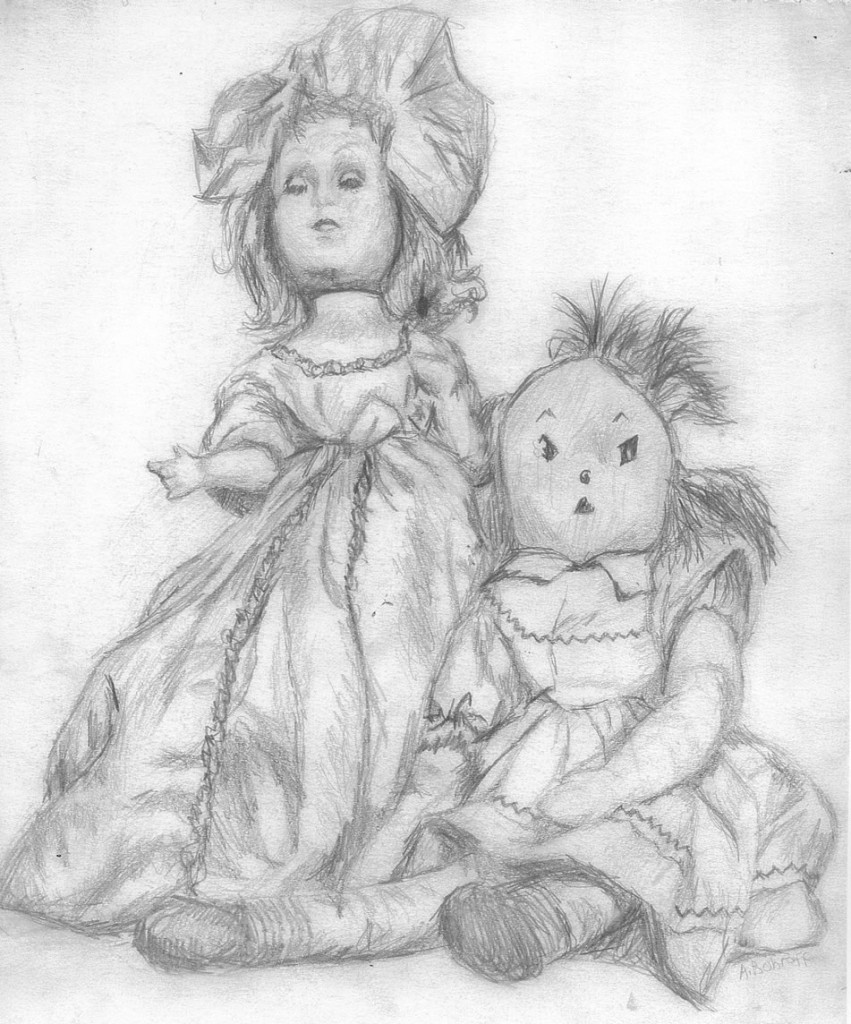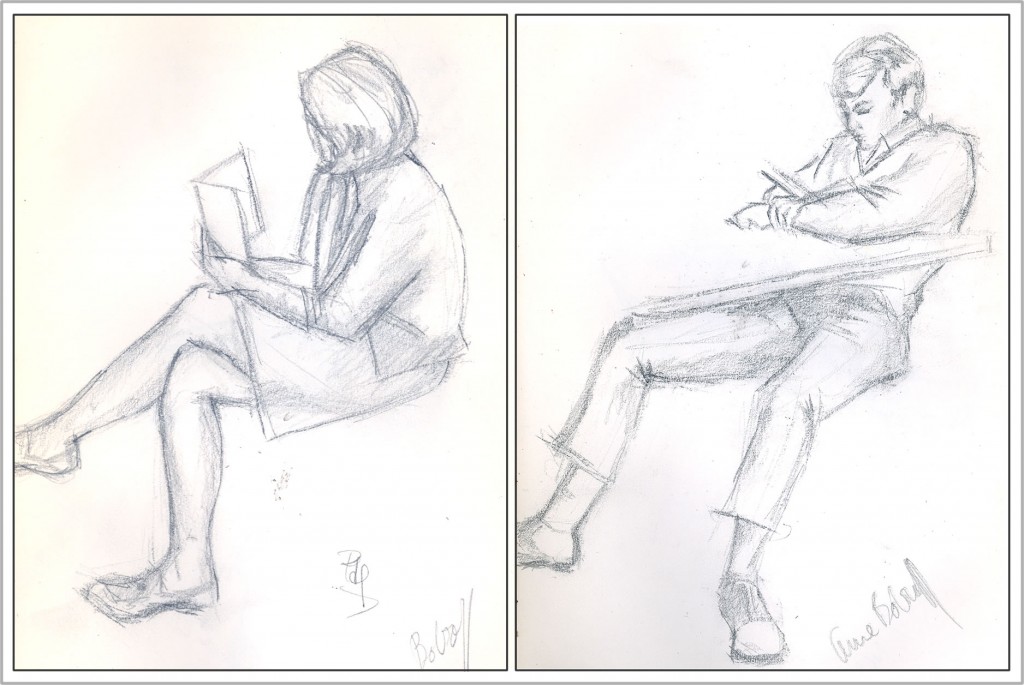Non-artists often admire artists’ ability to draw. They wish they could learn how. Many assume being an artist is mainly having the skill to draw realistically.

My sister Ellen
It is a lot of fun to be able to draw. It’s fun to capture the reality of different shapes, textures, surfaces. I especially love the moment of finally succeeding in capturing some one doing some activity.
But thinking that drawing is the main role of an artist is like assuming that the main role of a professional mathematician is adding and subtracting. There’s a vast range of other skills that must be built atop the foundation of drawing, along with natural talent and a vision of what you want to create.
Like arithmetic for a mathematician, drawing is my most basic tool, the thing I’ve been doing since I was a little kid. I grew up drawing all the time. I used to pester my sisters endlessly to pose for me. Here’s a drawing of my sister Ellen. You can see she wouldn’t stay still long enough for me to add shading – I could only do a quick sketch before she’d run off and play outdoors.

Fancy doll and ragged Raggedy Ann
So I’d look for inanimate things to draw. Here are two of my dolls. They stayed still long enough for me to add detail to the sketch.
I’d set up still lifes using objects with different types of surfaces in order to figure out how to draw a shiny thing so it looked shiny, a furry thing so it looked look furry. I would puzzle over how you could make a candle flame look as bright in your drawing as it does in reality. How could I draw a transparent bottle to make it look transparent?
I drew in art classes in school – my ability in portraiture actually first emerged in a portrait I drew of a classmate. I drew the kids I babysat for. Their mother, thrilled with the likenesses, bought the portraits for what was for me a huge sum.
Actually, I drew in all my school classes, not just the art ones. It was a great way to alleviate boredom. My sketch book is full of drawings of the backs of classmates sitting at their desks, because that was all I could see in front of me. Though in study hall I could draw them from other angles. Below are a couple. Again, these had to be quick sketches before my fellow study hallers shifted position. I had minimal time for shading.

Two kids in my high school study hall
The most fun of all is life drawing classes. I got a scholarship to attend a life drawing class when I was about 15 (I was the only kid in the class. I had to get special permission from my parents because of the nude models). In life drawing, you’re given varying amounts of time to draw the model in different poses. Commonly, the amount of time is 5 minutes ranging down to 30 or even 10 seconds. The idea is to train the artist to be able to capture the essence of a person’s position very quickly, because in reality people don’t hold the same position for very long – as I’d discovered with my sisters and the kids in study halls.
The second classic life drawing challenge is to practice realistically drawing a hand or foot that’s coming straight at you instead of being seen from the side. Artists need to figure out how to draw people from all kinds of common but difficult angles without ending up with something that looks completely misshapen.
Below is the last drawing of the life drawing class I took in high school. As a reward at the end of the course, we were given 45 minutes to do this drawing. Next to that is one of my quick crayon sketches of a rare male life model. (Unfortunately, most life models are women. I find that sexist.)

A couple of my life drawings
In short, drawing for me, and for many other artists, is the thing we started doing as far back as we can remember. We need to keep doing it all our lives, just as mathematicians have to keep adding and subtracting.
But as in any field, there are many skills beyond the basics which the layperson may be unaware of. In art, these other skills and talents, not just drawing, distinguish great artists from mediocre ones. Many of my blog posts are about the range of these other skills and talents. Many involve artistic sensibility as well as knowledge, such as choice of color palette, medium, style, and subject matter; which elements of a scene you will include; the weight of each element compared all the others; lighting issues (the direction of the lighting, whether multiple light sources or one, quality of the light); and countless others.
Here is one example among the infinite number I could give of artistry over and above drawing. Alexandra Tyng, a highly successful portraitist, has written on the PortraitArtist.com Forum about her sophisticated method of thinking about and painting backgrounds:
The most important thing to keep in mind about backgrounds is that they are not actually separate from the figure. The background … is actually the air around the figure. It is three-dimensional space! It envelops the figure, surrounds it on all sides, and recedes from the picture plane to varying degrees….
Whether the background is plain or complex, the … figure emerges from the ground….
The key to achieving the illusion of “emergence” is to understand the roundness of the head (or figure) and the colors of the light in relation to the shadow. The side of the face in direct light gives the feeling of solidity and opacity. As the form turns away from the direct light, it picks up the indirect light or ambient light in the atmosphere. This indirect light is slightly redder than direct light. Crossing over the line into the shadow areas, the complement of the indirect light will predominate…..
An artist who uses Tyng’s approach to backgrounds will create a very different painting than an artist who approaches backgrounds differently.
The online Portrait Artist forum gives some idea of the many, many elements of artistry beyond simple drawing. And keep in mind, this forum covers representational portraiture. There are many other forms of art, and many, many other issues that artists must be skilled at in order to produce terrific art.
So if you’ve always wanted to improve your ability to draw, don’t view it as an end point, but as something to play with and experience. Play with drawing every chance you get. Draw different types of things – animate and inanimate, shiny and dull, smooth and rough. See if your friends or loved ones will pose for you. Set up your own still lifes to challenge yourself with different types of objects. Go to a park, beach, sports or music event and practice very quick sketches of people doing different activities. Take a life drawing class if you can and if it seems appealing.
And view drawing as one fun stepping stone on your path as an artist.




















isotretinoin 20mg drug azithromycin pills azithromycin order online
Порно комиксы онлайн
order generic indocin 50mg order terbinafine online buy trimox 250mg pills
https://cheapestedpills.com/# compare ed drugs
[url=https://cheapestedpills.shop/#]ed pills for sale[/url] erection pills viagra online
порно комиксы онлайн
Ремонт ноутбуков спб
ed in young men – male ed pills male enhancement
https://cheapestedpills.shop/# new treatments for ed
buy tadalafil 10mg for sale Buy viagra on internet buy sildenafil 100mg generic
Dead written articles, Really enjoyed reading through.
http://www.spb-center-remont-noutbukov.ru
Thanks on your marvelous posting! I actually enjoyed readingit, you are a great author.I will ensure that I bookmark your blog and may come back at some point.I want to encourage continue your great writing, have a nice weekend!
generic arimidex 1mg clarithromycin generic buy sildenafil pills